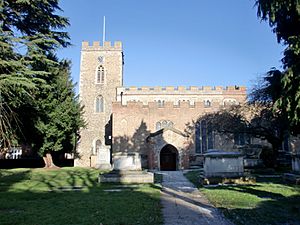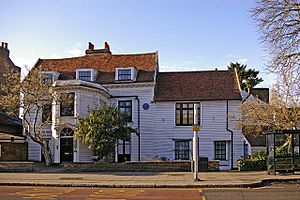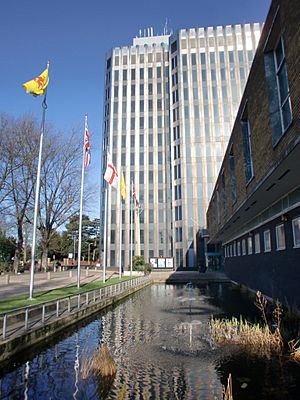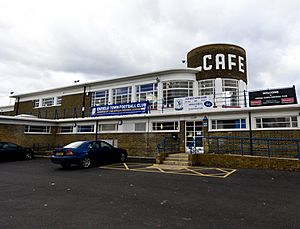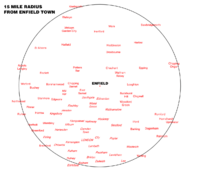Enfield, London facts for kids
Quick facts for kids Enfield |
|
|---|---|
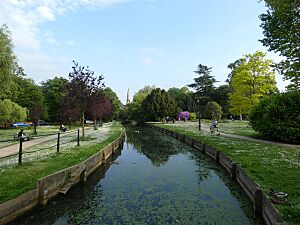 The New River Loop in Chase Green Gardens, Enfield |
|
| Population | 156,858 (2018) |
| OS grid reference | TQ325965 |
| London borough | |
| Ceremonial county | Greater London |
| Region | |
| Country | England |
| Sovereign state | United Kingdom |
| Post town | ENFIELD |
| Postcode district | EN1, EN2, EN3 |
| Post town | LONDON |
| Postcode district | N21 |
| Post town | WALTHAM CROSS |
| Postcode district | EN7, EN8 |
| Dialling code | 020 01992 (Bulls Cross, Bullsmoor, Freezywater and Enfield Lock parts) |
| Police | Metropolitan |
| Fire | London |
| Ambulance | London |
| EU Parliament | London |
| UK Parliament |
|
| London Assembly |
|
Enfield is a big town in north London, England. It's about 10 miles north of central London. In 2021, over 333,000 people lived here. Enfield includes many areas like Botany Bay, Brimsdown, Enfield Lock, and Ponders End.
Enfield is south of the Hertfordshire border and the M25 motorway. It shares borders with Waltham Cross to the north and Edmonton to the south. The River Lea is to its east.
Long ago, Enfield was an old parish in Middlesex. In 1965, it joined with Southgate and Edmonton to form the London Borough of Enfield. Enfield is now the main centre of this borough.
Enfield Town is the busy heart of Enfield. It became a market town in 1303, thanks to King Edward I. You can find St Andrew's Enfield, the oldest church, here. The eastern part of Enfield, near the River Lea, is known for its factories and history. The Royal Small Arms Factory at Enfield Lock used to make famous Enfield rifles. Forty Hall is a historic house in the north. The New River flows through Enfield, even looping around the town centre.
Contents
A Look Back in Time
Enfield has a long history! In Anglo-Saxon times, a nobleman named Ansgar owned the land. The name 'Enfield' probably means "open land belonging to a man called Ēana".
In 1086, after the Normans took over, a powerful Norman named Geoffrey de Mandeville owned Enfield. The first church records for St Andrew's Enfield date back to 1136. In 1303, King Edward I allowed a nobleman to hold a weekly market and two yearly fairs. This made Enfield a proper market town. Enfield was once the biggest parish in Middlesex.
In the 20th century, London grew so much that Enfield became part of the big city.
Famous Places and Events
The main church, St Andrew's Enfield, is on the north side of the marketplace. Parts of it are from the 13th century. Next to the church is the old building of Enfield Grammar School, which has been around since the Tudor period.
Enfield Palace
There was once a grand house called Enfield Palace. It's now remembered by the name of the Palace Gardens Shopping Centre. This house was used as a private school for many years. The last parts of it were taken down in 1928 to make way for a department store. However, a special room with a fancy ceiling and fireplace was saved and moved to another house nearby.
Enfield Market
In 1303, King Edward I gave permission for a weekly market in Enfield. Later, in 1617, King James I allowed a Saturday market. The market was very busy in the 1700s but then became less popular. People tried to bring it back, and in 1826, a stone market cross was built.
Even though some thought the market would never return, trading started again in the 1870s. Today, the market is still running!
The Enfield Fair
The 1303 charter also allowed two yearly fairs. One was on St Andrew's Day, and the other in September. The September fair was stopped in 1869. Local people felt it was causing problems and disorder.
The New River
The New River was built to bring water from Hertfordshire to London. It flows right behind Enfield's town centre, through the Town Park. A part of the New River even loops around the town centre.
Early Greenhouses
Enfield was home to some of the first successful hothouses in England. Dr Robert Uvedale (1642–1722), a headmaster and plant expert, developed them. He had a huge collection of exotic plants. He kept them in "six or seven houses" and even used special heated rooms for delicate plants.
John Keats, the Poet
The famous poet John Keats (1795-1821) went to school in Enfield. He started translating a famous old poem called the Aeneid there. His school building later became Enfield Town railway station, but it was replaced in the 1960s.
The White House
The White House on Silver Street is now a doctor's office. It used to be the home of Joseph Whitaker. He was the person who started Whitaker's Almanack, a famous book of facts.
World's First ATM
Did you know Enfield Town had the world's first cash machine? It's true! The automatic teller machine (ATM) was invented by John Shepherd-Barron. It was put in a Barclays Bank branch on June 27, 1967. An actor and local resident, Reg Varney, was the first person to use it.
The Civic Centre
The Enfield Civic Centre is in Enfield Town. This is where the local government for the borough has its main offices. Council meetings are held here.
People and Homes in Enfield
Enfield is made up of many neighbourhoods and villages. In 2018, the official population estimate for Enfield was 156,858 people.
In the 2011 census, most people in the Town ward (the central area) were white. The largest non-white group was Black African. Life expectancy was highest in the Highlands ward. It was 82.5 years for men and 87.2 years for women.
In Enfield Lock, most houses were rented. In Bush Hill Park, most houses were owned by the people living in them.
| Ward | Detached | Semi-detached | Terraced | Flats and apartments |
|---|---|---|---|---|
| Bush Hill Park | 5.0% | 32.6% | 34.3% | 28.0% |
| Chase | 9.2% | 19.8% | 33.4% | 37.1% |
| Enfield Highway | 4.5% | 22.0% | 38.8% | 34.6% |
| Enfield Lock | 6.8% | 20.4% | 32.6% | 40.2% |
| Grange | 15.5% | 32.6% | 13.5% | 38.4% |
| Highlands | 14.5% | 34.0% | 13.4% | 38.0% |
| Southbury | 3.3% | 14.1% | 43.4% | 39.2% |
| Town | 2.7% | 29.2% | 36.6% | 31.5% |
| Turkey Street | 4.3% | 26.6% | 36.1% | 33.1% |
Sports in Enfield
Enfield has two main football teams. Enfield Football Club was formed in 1893. Enfield Town Football Club started in 2001 and plays at Enfield's Queen Elizabeth II Stadium.
Enfield Town L.F.C. is the women's football team, also playing at the Queen Elizabeth II Stadium.
The North Enfield Cricket Club started in 1886. They have played at Clay Hill since 1945.
Getting Around Enfield
Enfield Town is about 10 miles north of central London. It's also close to other towns like Cheshunt and Potters Bar.
Train Stations
Enfield Town railway station is in the middle of Enfield Town. It's one of the stations on the Lea Valley lines that go to Liverpool Street in London. London Overground trains run on this line. Other stations nearby include Bush Hill Park.
The Southbury Loop train line also runs through Enfield. It has stations like Southbury and Turkey Street.
The West Anglia Main Line goes through Ponders End, Brimsdown, and Enfield Lock stations. Greater Anglia trains use this line.
On the west side of town, Enfield Chase railway station is on the Hertford Loop line. Thameslink trains go from here to Moorgate and other towns. Other stations on this line are Crews Hill, Gordon Hill, and Grange Park.
Bus Services
Many London Buses routes serve Enfield. These include routes 121, 191, 192, 217, 231, 279, 299, 307, 313, 317, 329, 349, 377, 456, 629, W8, W9, and W10. There are also night buses, N29 and N279. Some non-London bus routes also pass through Enfield.



